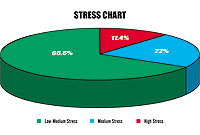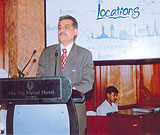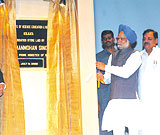|
Indian CEOs stressed out |
India 12th wealthiest nation |
 |

|
Business honchos in India suffer from a fair degree of stress but surprisingly do not seek medical intervention, instead cope with their work pressure by reading books or spending more time with their families, a survey conducted by the Associated Chambers of Commerce and Industry (Assocham) has shown.
Severe business competition (SBC), excessive travelling, deadlines, multi-tasking and increasing business pressure are some of the stress factors amongst the Indian CEO’s, an Assocham Business Barometer (ABB) survey has revealed.
In its survey of around 270 CEOs, 66.6 per cent were stressed mainly because of severe business competition. As many as 22 per cent said the stress level was moderate while 11.4 per cent said it was too much to handle.
About 70 per cent of the industry leaders coping with the work pressure suffer more of a mental stress than the physical strain, the survey covering most of the industry sectors showed. |
India has emerged as the 12th wealthiest nation in the world with its GDP touching $785.47 billion or Rs 35,34,615 crore in 2005, calculated by the World Bank. The US was the wealthiest nation with GDP of $12.46 trillion, according to a list of 15 wealthiest countries prepared by the World Bank in terms of their gross domestic product.
The GDP figures have been adjusted to reflect purchasing power.
While India was way down compared to China, positioned fourth with $2.23 trillion of GDP, it was wealthier than Mexico, Russia and Australia. The US was followed by Japan with $4.51 trillion and Germany $2.78 trillion. Britain, France and Italy occupied fifth, sixth and seventh rank with GDP of $2.19 trillion, $2.11 trillion and $1.72 trillion, respectively.
Next came Spain, Canada, Brazil and South Korea with their GDP estimated at $1.124 trillion, $1.115 trillion, $794.10 billion and $787.62 billion, respectively. |
|
|

|
|
Get Ready For A Filmy Holiday With “Locations”
|
Prime minister says science must get priority
|
|

|

|
“Sunlight, action, cut,” are the most likely words you would hear on the sets of a film directed at the sites of Locations, a pioneer in film tourism. Set up four years ago, the company is set to divert the heavy traffic of Indian films shot abroad back to India.
“With the sun staying in the sky for 12 hours, India gives a massive advantage to filmmakers. Also, the sites are so majestic and beautiful,” said Locations chairman Manik Shah. And Shah was not just talking about the traditionally popular sites like Taj Mahal, Red Fort or the palaces of Rajasthan and Mysore. His company, he said, was in the process of identifying many “virgin sites” that could be economical and attractive to filmmakers.
Locations, a bright new concept in filmmaking, caters to film units and their international shoot needs. Given the awesome record of the Indian film industry, who would blame Locations for setting its sights high?
India produces over 1,000 feature films, 2,000 music videos, 5,000 ad films and 10,000 TV serials in 21 languages annually. Every 2nd feature film, every 3rd music video, every 5th ad film and every 50th TV serial is, however, shot on foreign locations. This adds up to a total business worth $500 million.
Locations is owned by MMS Holdings. Besides catering to the shoot needs of film units, it organises conferences, health and adventure sports and leisure tourism. For more information, contact Ravi Dey at 09892432732 and Rajeev at 9350589275.
|
Prime Minister Manmohan Singh has declared his government’s commitment to “massive expansion” of education in order for the country to position itself as a knowledge economy.
Laying the foundation stone for the Indian Institute of Science Education and Research in Kolkata, he said the government would commit adequate resources for a massive expansion in higher education system so that every section of society has adequate opportunities for fulfilling their educational aspirations.
“This expansion has become even more pressing because we cannot continue to claim to be a rising “knowledge power” if less than 8% of our college going age group is enrolled in the college and university system. We cannot have pretensions about being a leading “knowledge power” if we do not substantially upgrade our scientific and technological expertise — both in quality and quantity”, he said.
He said the Rand Corporation recently classified 22 of 192 nations of the world as scientifically advanced, 24 as scientifically proficient, 40 as scientifically developing and the rest as deficient. India is ranked among the scientifically proficient nations. “China and South Korea are far ahead of us in investing in the future of science and technology in their countries. We need to do much more in this vital area if we have to keep pace with the evolving global economy of the future,” he said.
|
|
|
|
|